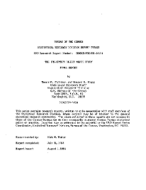
An official website of the United States government
Here’s how you know
Official websites use .gov
A .gov website belongs to an official government organization in the United States.
Secure .gov websites use HTTPS
A lock (
) or https:// means you’ve safely connected to the .gov website. Share sensitive information only on official, secure websites.
-
//
- Census.gov /
- Library /
- Census Working Papers /
- The IRS/Census Direct Match Study Final Report
The IRS/Census Direct Match Study Final Report
The IRS/Census Direct Match Study Final Report
Introduction
This project has two principal aims: to investigate the feasibility of using the Internal Revenue Service Individual Master File (IRWIMFI as a frame for matching to the census in order to estimate gross undercoverage in the census, and to study the difficulties in tracing individuals to the census using the IRS/IMF address.
There has been much discussion recently about using administrative records as a tool in evaluating the census. A combination of administrative records, such as IRS, Medicare, birth and death records, welfare, and other records, has been termed the megalist approach. The IRS/Census Direct Match Study took a sample of persons who filed 1979 tax returns in April 1980. These joint and single filers were matched to the 1980 Decennial Census. Thus, this study can be considered to be a test of the IRS portion of the megalist or composite list for the working age population 18 to 65 years of age.
There are several possible advantages in using the IRS/IMF as the frame from which to draw a sample which will be independent of the census. Since it is not based on household interviews, it is unlikely to reproduce the same omissions as the census. It is especially good for groups with traditionally poor census coverage, such as young working age males. Samoling can be easily controlled on race and income thus permitting the over sampling of black, hispanic, poor, or other “hard to enumerate” groups.
Tracing is a key activity in the proposals for census coverage evaluation research. However, tracing is expensive and time consuming. Tracing will rely heavily on the use of administrative files, such as the IRS/IMF, which will be used to locate a more recent address. The IRS/Census match uses the IRS/IWIF directly to obtain a census day residence address to match to the census. It thus increases the understanding of the IRS/IMF as an important tracing tool.
The match from IRS records to census records is conceptually simple. A sample was drawn from the 1979 IRS tax return file. The listing included the name and address of the taxpayer and spouse. The addresses were then coded to census geography and a search of census records was made to see if the sample persons were enumerated in the 1980 Decennial Census. If a person was not enumerated at the tax return address or if we could not code the address to census geography, the sample person was contacted to obtain a correct address or to determine if there existed another address at which the person was enumerated. The sample percentage unmatched will be used as an estimate of census incompleteness for the working age population. The estimates of gross percent enumerated from this study cannot be compared to the Demographic Analysis estimates or the net percent missed from the Post Enumeration Program.
Others in Series
Working Paper
Working Paper
Working Paper
Share
Related Information
WORKING PAPER
Statistical Research Reports and StudiesSome content on this site is available in several different electronic formats. Some of the files may require a plug-in or additional software to view.
 Yes
Yes
 No
NoComments or suggestions?


Top

